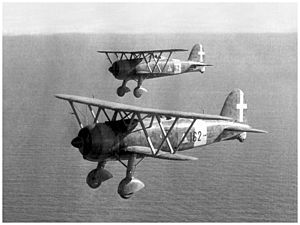Fiat CR.42
| CR.42 Falco | |
|---|---|
 |
|
| Two CR.42's of 162nd Squadron, 161st "Autonomous Terrestrial Fighter Group", Aegean Islands 1940 | |
| Role | Fighter |
| National origin | Italy |
| Manufacturer | Fiat Aviazione |
| Designer | Celestino Rosatelli |
| First flight | 23 May 1938 |
| Introduction | 1939 |
| Retired | 1948 Spanish Air Force |
| Primary users |
Regia Aeronautica Spanish Air Force |
| Produced | c. February 1939 - Late 1943 |
| Number built | 1,817-1,819 |
| Developed from | Fiat CR.32 |
The Fiat CR.42 Falco ("Falcon", plural: Falchi) was a single-seat sesquiplane fighter that served primarily in Italy's Regia Aeronautica before and during World War II. The aircraft was produced by Fiat Aviazione, and entered service, in smaller numbers, with the air forces of Belgium, Sweden and Hungary. With more than 1,800 built, it was the most numerous Italian aircraft in World War II. The CR.42 was the last of the Fiat biplane fighters to enter front line service, and represented the epitome of the type, along with the Gloster Gladiator.
RAF Intelligence praised its exceptional manoeuvrability, further noting that "the plane was immensely strong", though it stood little chance against faster, more heavily armed monoplanes. It performed at its best with the Hungarian Air Force on the Eastern Front, where it had a kill to loss ratio of 12 to 1.
The CR.42 was an evolutionary design based on the earlier Fiat CR.32, which was in turn derived from the Fiat CR.30 series created in 1932. The Regia Aeronautica had employed the CR.32 during the Spanish Civil War with great success, which led to Fiat proposing a more advanced fighter based around the supercharged Fiat A.74R1C.38 air-cooled radial engine geared to drive a metal three-blade Fiat-Hamilton Standard 3D.41-1 propeller of 2.9 metres (9 ft 6 in) diameter and a robust, clean, sesquiplane design. The rigidly braced wings covered with fabric were constructed from light duralumin alloy and steel. It reached a top speed of 438 km/h (272 mph) at 5,300 m (17,400 ft) and 342 km/h (213 mph) at ground level. Climb rate was 1 minute and 25 seconds to 1,000 m (3,280 ft) and of 7 minutes and 20 seconds to 6,000 m (19,700 ft).
In spite of the biplane configuration, the CR.42 was a modern, "sleek-looking" design based around a strong steel and alloy frame incorporating a NACA cowling housing the radial engine, with fairings for the fixed main landing gear. The CR.42's upper wing was larger than its lower wing, a configuration known as a sesquiplane. The aircraft proved exceptionally agile thanks to its very low wing loading, although at the same time, the CR.42 lacked armour and radio equipment.
...
Wikipedia
